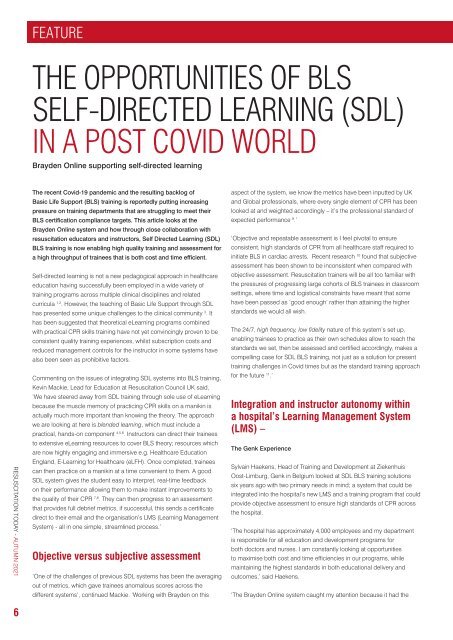Resus Today Autumn 2021
Resus Today Autumn 2021
Resus Today Autumn 2021
Create successful ePaper yourself
Turn your PDF publications into a flip-book with our unique Google optimized e-Paper software.
FEATURE<br />
THE OPPORTUNITIES OF BLS<br />
SELF-DIRECTED LEARNING (SDL)<br />
IN A POST COVID WORLD<br />
Brayden Online supporting self-directed learning<br />
RESUSCITATION TODAY - AUTUMN <strong>2021</strong><br />
The recent Covid-19 pandemic and the resulting backlog of<br />
Basic Life Support (BLS) training is reportedly putting increasing<br />
pressure on training departments that are struggling to meet their<br />
BLS certification compliance targets. This article looks at the<br />
Brayden Online system and how through close collaboration with<br />
resuscitation educators and instructors, Self Directed Learning (SDL)<br />
BLS training is now enabling high quality training and assessment for<br />
a high throughput of trainees that is both cost and time efficient.<br />
Self-directed learning is not a new pedagogical approach in healthcare<br />
education having successfully been employed in a wide variety of<br />
training programs across multiple clinical disciplines and related<br />
curricula 1,2 . However, the teaching of Basic Life Support through SDL<br />
has presented some unique challenges to the clinical community 3 . It<br />
has been suggested that theoretical eLearning programs combined<br />
with practical CPR skills training have not yet convincingly proven to be<br />
consistent quality training experiences, whilst subscription costs and<br />
reduced management controls for the instructor in some systems have<br />
also been seen as prohibitive factors.<br />
Commenting on the issues of integrating SDL systems into BLS training,<br />
Kevin Mackie, Lead for Education at <strong>Resus</strong>citation Council UK said,<br />
‘We have steered away from SDL training through sole use of eLearning<br />
because the muscle memory of practicing CPR skills on a manikin is<br />
actually much more important than knowing the theory. The approach<br />
we are looking at here is blended learning, which must include a<br />
practical, hands-on component 4,5,6 . Instructors can direct their trainees<br />
to extensive eLearning resources to cover BLS theory; resources which<br />
are now highly engaging and immersive e.g. Healthcare Education<br />
England, E-Learning for Healthcare (eLFH). Once completed, trainees<br />
can then practice on a manikin at a time convenient to them. A good<br />
SDL system gives the student easy to interpret, real-time feedback<br />
on their performance allowing them to make instant improvements to<br />
the quality of their CPR 7,8 . They can then progress to an assessment<br />
that provides full debrief metrics, if successful, this sends a certificate<br />
direct to their email and the organisation’s LMS (Learning Management<br />
System) - all in one simple, streamlined process.’<br />
Objective versus subjective assessment<br />
‘One of the challenges of previous SDL systems has been the averaging<br />
out of metrics, which gave trainees anomalous scores across the<br />
different systems’, continued Mackie. ‘Working with Brayden on this<br />
aspect of the system, we know the metrics have been inputted by UK<br />
and Global professionals, where every single element of CPR has been<br />
looked at and weighted accordingly – it’s the professional standard of<br />
expected performance 9 .’<br />
‘Objective and repeatable assessment is I feel pivotal to ensure<br />
consistent, high standards of CPR from all healthcare staff required to<br />
initiate BLS in cardiac arrests. Recent research 10 found that subjective<br />
assessment has been shown to be inconsistent when compared with<br />
objective assessment. <strong>Resus</strong>citation trainers will be all too familiar with<br />
the pressures of progressing large cohorts of BLS trainees in classroom<br />
settings, where time and logistical constraints have meant that some<br />
have been passed as ‘good enough’ rather than attaining the higher<br />
standards we would all wish.<br />
The 24/7, high frequency, low fidelity nature of this system’s set up,<br />
enabling trainees to practice as their own schedules allow to reach the<br />
standards we set, then be assessed and certified accordingly, makes a<br />
compelling case for SDL BLS training, not just as a solution for present<br />
training challenges in Covid times but as the standard training approach<br />
for the future 11 .’<br />
Integration and instructor autonomy within<br />
a hospital’s Learning Management System<br />
(LMS) –<br />
The Genk Experience<br />
Sylvain Haekens, Head of Training and Development at Ziekenhuis<br />
Oost-Limburg, Genk in Belgium looked at SDL BLS training solutions<br />
six years ago with two primary needs in mind; a system that could be<br />
integrated into the hospital’s new LMS and a training program that could<br />
provide objective assessment to ensure high standards of CPR across<br />
the hospital.<br />
‘The hospital has approximately 4,000 employees and my department<br />
is responsible for all education and development programs for<br />
both doctors and nurses. I am constantly looking at opportunities<br />
to maximise both cost and time efficiencies in our programs, while<br />
maintaining the highest standards in both educational delivery and<br />
outcomes,’ said Haekens.<br />
‘The Brayden Online system caught my attention because it had the<br />
6

















